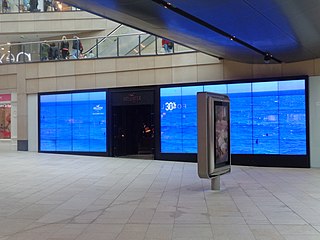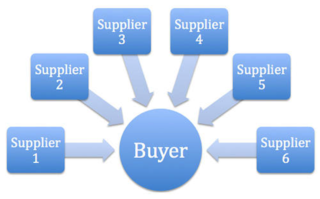
In commerce, supply chain management (SCM) deals with a system of procurement, operations management, logistics and marketing channels, so that the raw materials can be converted into a finished product and delivered to the end customer. A more narrow definition of the supply chain management is the "design, planning, execution, control, and monitoring of supply chain activities with the objective of creating net value, building a competitive infrastructure, leveraging worldwide logistics, synchronising supply with demand and measuring performance globally". This can include the movement and storage of raw materials, work-in-process inventory, finished goods, and end to end order fulfilment from the point of origin to the point of consumption. Interconnected, interrelated or interlinked networks, channels and node businesses combine in the provision of products and services required by end customers in a supply chain.

Sales are activities related to selling or the number of goods sold in a given targeted time period. The delivery of a service for a cost is also considered a sale. A period during which goods are sold for a reduced price may also be referred to as a "sale".
Procurement is the process of locating and agreeing to terms and purchasing goods, services, or other works from an external source, often with the use of a tendering or competitive bidding process. The term may also refer to a contractual obligation to "procure", i.e. to "ensure" that something is done. When a government agency buys goods or services through this practice, it is referred to as government procurement or public procurement.
Purchasing is the process a business or organization uses to acquire goods or services to accomplish its goals. Although there are several organizations that attempt to set standards in the purchasing process, processes can vary greatly between organizations.
E-procurement is the business-to-business or business-to-consumer or business-to-government purchase and sale of supplies, work, and services through the Internet as well as other information and networking systems, such as electronic data interchange and enterprise resource planning.
In the United States, a group purchasing organization (GPO) is an entity that is created to leverage the purchasing power of a group of businesses to obtain discounts from vendors based on the collective buying power of the GPO members.
Strategic sourcing is the process of developing channels of supply at the lowest total cost, not just the lowest purchase price. It expands upon traditional organisational purchasing activities to embrace all activities within the procurement cycle, from specification to receipt, payment for goods and services to sourcing production lines where the labor market would increase firms' ROI. Strategic sourcing processes aim for continuous improvement and re-evaluation of the purchasing activities of an organisation.
The Defence Logistics Organisation (DLO) was a key element of the UK Ministry of Defence, responsible for supporting the armed forces throughout the various stages of an operation or exercise; from training, deployment, in-theatre training and conduct of operations, through to recovery and recuperation ready for redeployment.
Supplier relationship management (SRM) is the systematic, enterprise-wide assessment of suppliers' strengths, performance and capabilities with respect to overall business strategy, determination of what activities to engage in with different suppliers, and planning and execution of all interactions with suppliers, in a coordinated fashion across the relationship life cycle, to maximize the value realized through those interactions. The focus of supplier relationship management is the development of two-way, mutually beneficial relationships with strategic supply partners to deliver greater levels of innovation and competitive advantage than could be achieved by operating independently or through a traditional, transactional purchasing arrangement. Underpinning disciplines which support effective SRM include supplier information management, compliance, risk management and performance management.
The following outline is provided as an overview of and topical guide to business management:
Procurement outsourcing is the transfer of specified key procurement activities relating to sourcing and supplier management to a third party — perhaps to reduce overall costs or maybe to tighten the company's focus on its core competencies. Procurement categorisation and vendor management of indirect materials and services are typically the most popular outsourced activity.
Sustainable procurement or green procurement is a process whereby organizations meet their needs for goods, services, works and utilities in a way that achieves value for money on a life-cycle basis while addressing equity principles for sustainable development, therefore benefiting societies and the environment across time and geographies. Procurement is often conducted via a tendering or competitive bidding process. The process is used to ensure the buyer receives goods, services or works for the best possible price, when aspects such as quality, quantity, time, and location are compared. Procurement is considered sustainable when organizations broadens this framework by meeting their needs for goods, services, works, and utilities in a way that achieves value for money and promotes positive outcomes not only for the organization itself but for the economy, environment, and society. This framework is also known as the triple bottom line, which is a business accounting framework. The concept of TBL is narrowly prescribed, and even John Elkington, who coined the term in the 1990s, now advocates its recall. Indeed, procurement practitioners have drawn attention to the fact that buying from smaller firms, locally, is an important aspect of sustainable procurement in the public sector. Ethics, culture, safety, diversity, inclusion, justice, human rights and the environment are additionally listed as important aspects of SPP.

Government procurement or public procurement is the procurement of goods, services and works on behalf of a public authority, such as a government agency. Amounting to 12 percent of global GDP in 2018, government procurement accounts for a substantial part of the global economy.
A chief procurement officer (CPO) undertakes an executive role within an enterprise, focusing on sourcing, procurement, and supply management.
Spend analysis or spend analytics is the process of collecting, cleansing, classifying and analyzing expenditure data with the purpose of decreasing procurement costs, improving efficiency, and monitoring controls and compliance. It can also be leveraged in other areas of business such as inventory management, contract management, complex sourcing, supplier management, budgeting, planning, and product development.
Procure-to-pay is a term used in the software industry to designate a specific subdivision of the procurement process.

A reverse auction is a type of auction in which the traditional roles of buyer and seller are reversed. Thus, there is one buyer and many potential sellers. In an ordinary auction also known as a forward auction, buyers compete to obtain goods or services by offering increasingly higher prices. In contrast, in a reverse auction, the sellers compete to obtain business from the buyer and prices will typically decrease as the sellers underbid each other.
JAGGAER, formerly SciQuest, is a provider of cloud-based business automation technology for Business Spend Management. Its headquarters is in Morrisville, North Carolina and it has offices around the world. The company's tagline is Procurement Simplified.
Category management is an approach to the organisation of purchasing within a business organisation. Applying category management to purchasing activity benefits organisations by providing an approach to reduce the cost of buying goods and services, reduce risk in the supply chain, increase overall value from the supply base and gain access to more innovation from suppliers. It is a strategic approach which focuses on the vast majority of organisational spend. If applied effectively throughout an entire organisation, the results can be significantly greater than traditional transactional based purchasing negotiations, however the discipline of category management is sorely misunderstood.
At around £290 billion every year, public sector procurement accounts for around a third of all public expenditure in the UK. EU-based laws continue to apply to government procurement: procurement is governed by the Public Contracts Regulations 2015, Part 3 of the Small Business, Enterprise and Employment Act 2015, and the Public Contracts (Scotland) Regulations of 2015 and 2016. These regulations implement EU law, which applied in the UK prior to Brexit, and also contain rules known as the "Lord Young Rules" promoting access for small and medium enterprise (SMEs) to public sector contracts, based on Lord Young's Review Growing Your Business, published in 2013.




